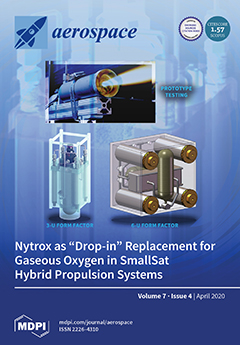Open AccessArticle
Effect of Levels of Fidelity on Steady Aerodynamic and Static Aeroelastic Computations
by
Adrien Crovato, Hugo S. Almeida, Gareth Vio, Gustavo H. Silva, Alex P. Prado, Carlos Breviglieri, Huseyin Guner, Pedro H. Cabral, Romain Boman, Vincent E. Terrapon and Grigorios Dimitriadis
Cited by 10 | Viewed by 5267
Abstract
Static aeroelastic deformations are nowadays considered as early as in the preliminary aircraft design stage, where low-fidelity linear aerodynamic modeling is favored because of its low computational cost. However, transonic flows are essentially nonlinear. The present work aims at assessing the impact of
[...] Read more.
Static aeroelastic deformations are nowadays considered as early as in the preliminary aircraft design stage, where low-fidelity linear aerodynamic modeling is favored because of its low computational cost. However, transonic flows are essentially nonlinear. The present work aims at assessing the impact of the aerodynamic level of fidelity used in preliminary aircraft design. Several fluid models ranging from the linear potential to the Navier–Stokes formulations were used to solve transonic flows for steady rigid aerodynamic and static aeroelastic computations on two benchmark wings: the Onera M6 and a generic airliner wing. The lift and moment loading distributions, as well as the bending and twisting deformations predicted by the different models, were examined, along with the computational costs of the various solutions. The results illustrate that a nonlinear method is required to reliably perform steady aerodynamic computations on rigid wings. For such computations, the best tradeoff between accuracy and computational cost is achieved by the full potential formulation. On the other hand, static aeroelastic computations are usually performed on optimized wings for which transonic effects are weak. In such cases, linear potential methods were found to yield sufficiently reliable results. If the linear method of choice is the doublet lattice approach, it must be corrected using a nonlinear solution.
Full article
►▼
Show Figures





